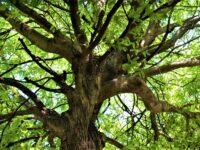Trees are the underrated superheroes of planet Earth. They sustain human life by mediating droughts, capturing rainwater, increasing healthy soil, conserving energy, providing food, preventing water pollution, and creating and cleaning the air we breathe. Trees serve as essential caretakers for humans and the environments we inhabit. Moreover, trees heal. They have been shown to improve physical and mental health, spark community involvement and togetherness in green spaces, inspire exploration of the outdoors, and even reduce violence. Neighborhoods protected by lush trees and landscaping tend to reduce fear levels and retain lowered incidences of violence in comparison to more barren areas and communities. Mental illnesses affect people of all ages and walks of life, and access to trees has proven to facilitate the healing processes for diverse types of patients and reduce symptoms. In response to trees’ relevance in human life and the environment, it is vital to study and comprehend their conditions to better maintain and protect the forests that sustain our Earth.
In 2016, a study led by Greg Gilbert at the Gilbert Lab at the University of California, Santa Cruz, analyzed the amount of internal decay and estimated damage present in living trees using the invisible yet powerful tool of sound. Sonic or acoustic tomography is a type of specialized equipment that scientists use to send sound waves through trees and measure the amount of time it takes sound to pass through each tree. By utilizing imaging techniques, the research team was able to convert the recorded sound waves into visual density color maps that illustrated the internal tissue makeup of trees. This form of high-powered tree technology translates tree health into a vibrant display of rainbow hues that represent the varying levels of decay or damage in the tree’s vital tissue.
For instance, in the tropical rainforests of the Republic of Panama, live tree trunks ranging from a plethora of tree species were scanned with an Argus Electronic PiCUS 3 Sonic Tomograph by Gilbert’s research team. Visual patterns and colors were developed with the sonic data acquired by the tomograph to demonstrate internal patterns of decay within the rainforest trees. Often, internal decay, also known as heart rot, is forensically determined by chopping down trees and analyzing wood decay. On the contrary, this innovative and non-invasive sonic technology of tomography was utilized in the study to complete highly visualizable results without the act of cutting down or harming trees.
Other non-invasive techniques including ultrasound, stress waves, and nuclear magnetic resonance have been used previously in wood decay studies but have never created fully reliable statistical representations. The PiCUS 3 Sonic Tomograph used by the Gilbert lab was proven to effectively and reliably detect decay and tree damage. According to the results of the study, sonic tomography and image analysis were proven to create a comprehensive approach to analyzing decay patterns and damage in tree tissue with a non-invasive approach. The knowledge accumulated by this study along with several other somatic applications to trees has allowed for a better understanding of tropical tree systems. Urban forestry has been found to benefit from sonic tomography technology, as the Gilbert lab’s data is being applied to assess the health risks of urban trees in the Republic of Panama that have decayed or are vulnerable to destruction from environmental causes or harsh weather events.
“While their accomplishments prove them as unquestionable superheroes, they are not indestructible; natural ecosystems that house trees remain in endemic insecurity.”
Trees foster a healthy life in both the biological and social spheres of Earth. While their accomplishments prove them as unquestionable superheroes, they are not indestructible; natural ecosystems that house trees remain in endemic insecurity. Deforestation due to industrial agriculture, illegal logging, infrastructure expansion, and wildfires caused by climate change are growing obstacles that leave trees in continuous peril. To better understand trees’ state in our environment, it is crucial to investigate trees, conduct research about their conditions, and analyze their decay and internal damage. Trees must be protected if they are to continue to stand tall as our heroes, protectors, and friends on Earth.
Image courtesy of Public Domain Pictures

